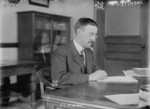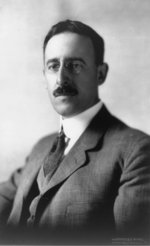![Stimson file photo [6823] Stimson file photo [6823]](/images/person_stimson1.jpg)
Henry Stimson
| Surname | Stimson |
| Given Name | Henry |
| Born | 21 Sep 1867 |
| Died | 20 Oct 1950 |
| Country | United States |
| Category | Government |
| Gender | Male |
Contributor: David Stubblebine
ww2dbaseHenry Lewis Stimson was an American statesman who served six presidents. A conservative Republican and something of an imperialist, he is best known as the Secretary of War during World War II under Democratic President Franklin Roosevelt. Chosen for his aggressive stance against Nazi Germany and strong opposition to Japanese aggression, he had responsibility for the Army (including Air Forces). He managed the conscription and training of 12 million soldiers and airmen, the purchase and transportation to battlefields of 30 percent of the nation's industrial output, and the building and decision to use the atomic bomb.
ww2dbaseBorn to a wealthy New York family long involved in Republican Party politics, he was educated at Phillips Academy in Andover, Massachusetts, and Yale College (BA 1888), where he was elected to Skull and Bones, a secret society that afforded many contacts for the rest of his life. In 1906 President Theodore Roosevelt appointed him U.S. Attorney for the Southern District of New York. Here he made a distinguished record prosecuting antitrust cases. Stimson was defeated as Republican candidate for governor of New York in 1910.
ww2dbaseStimson was first appointed Secretary of War in 1911 under President William Howard Taft, a post he held for two years. He continued the reorganization of the Army prior to its vast expansion in World War I. Following the outbreak of war, he went on to serve the U.S. Army in France as an artillery officer, reaching the rank of Colonel in August 1918.
ww2dbaseIn 1927, Stimson was sent by President Calvin Coolidge to Nicaragua for civil negotiations and was appointed Governor-General of the Philippines from 1927 to 1929.
ww2dbaseHe served as Secretary of State under President Herbert Hoover from 1929 to 1933. In 1929 he shut down the State Department's cryptanalytic office saying, "Gentlemen don't read each other's mail." (He later reversed this attitude.)
ww2dbaseDuring 1930 to 1932 Stimson was the Chairman of the U.S. delegation to the London Naval Conference in 1930-1931 and of the U.S. delegation to the Geneva Disarmament Conference in 1932. Also in 1932, the United States issued the "Stimson Doctrine" as a result of the Japanese Invasion of Manchuria: the United States refused to recognize any situation or treaty that limited U.S. treaty rights or was brought about by aggression. Returning to private life at the end of Hoover's administration, Stimson was an outspoken opponent of Japanese aggression.
ww2dbaseIn 1940 President Franklin D. Roosevelt returned Stimson to his old post as the Secretary of War, a position he held until after war's end. Prior to 1947 and the creation of the Secretary of Defense, what was called "the Secretary of War" was effectively "the Secretary of the Army," with a corresponding Cabinet post called "Secretary of the Navy" (Frank Knox, 1940-1944).
ww2dbaseTen days before the Attack on Pearl Harbor, Stimson entered in his diary a famous and much-argued statement. He had met with President Roosevelt to discuss the evidence of impending hostilities with Japan, and the question was "how we should maneuver them [the Japanese] into the position of firing the first shot without allowing too much danger to ourselves."
ww2dbaseStimson went on to skillfully direct the rapid, tremendous expansion of the Army to a force of over 10,000,000 soldiers.
ww2dbaseUnder Truman's administration, Stimson was the major decision-maker on the atomic bomb. Both Roosevelt and Truman followed his advice on every aspect of the bomb and Stimson overruled the military when needed (for example, by taking the cultural center Kyoto, where he had spent his honeymoon, off the target list). On August 6, 1945, the first atomic bombing destroyed Hiroshima.
ww2dbaseStimson strongly opposed the Morgenthau Plan to de-industrialize and partition Germany into several smaller states. The plan also envisioned the deportation and summary imprisonment of anybody suspected of responsibility for Nazi war crimes. Initially, Roosevelt was sympathetic to this plan but due to Stimson's opposition and the public outcry when the plan was leaked, he backtracked. The Morgenthau plan never went into effect per se, but did influence the early occupation, thus Stimson retained overall control of the U.S. occupation zone in Germany. Stimson insisted to Roosevelt that ten European countries, including Russia, depended upon Germany's export-import trade and production of raw materials and that it was inconceivable that this "gift of nature," populated by peoples of "energy, vigor, and progressiveness," could be turned into a "ghost territory" or "dust heap," thus sowing the seeds of what would later become the Marshall Plan.
ww2dbaseStimson, a lawyer, insisted (against the initial wishes of both Roosevelt and Churchill) on proper judicial proceedings against leading war criminals. He and the United States Department of War drafted the first proposals for an International Tribunal, which soon received backing from the incoming President Truman. Stimson's plan eventually led to the Nuremberg Trials of 1945-46, which have had a significant impact on the development of International Law.
ww2dbaseHenry Stimson died in October 1950 at age 83. At the time of his death, Stimson was the last surviving member of William Howard Taft's Cabinet.
ww2dbaseSource: Wikipedia
Last Major Revision: Nov 2008
Henry Stimson Interactive Map
Photographs
 |  |  |  |
Henry Stimson Timeline
| 21 Sep 1867 | Henry Stimson was born. |
| 22 May 1911 | Henry Stimson became the United States Secretary of War. |
| 4 Mar 1913 | Henry Stimson stepped down from his position as the United States Secretary of War. |
| 27 Dec 1927 | Henry Stimson became the Governor-General of the Philippines. |
| 23 Feb 1929 | Henry Stimson stepped down from his position as the Governor-General of the Philippines. |
| 28 Mar 1929 | Henry Stimson became the United States Secretary of State. |
| 4 Mar 1933 | Henry Stimson stepped down from his position as the United States Secretary of State. |
| 10 Jul 1940 | Henry Stimson became the United States Secretary of War. |
| 13 Aug 1940 | US President Franklin Roosevelt met with Secretary of the Navy Frank Knox, Secretary of War Henry L. Stimson, Secretary of the Treasury Henry Morgenthau, and Undersecretary of State Sumner Welles regarding the possibilities of transferring destroyers to the United Kingdom. Later on the same day, Roosevelt sent a telegram to British Prime Minister Winston Churchill via Acting Secretary of State Sumner Welles and Ambassador to London Joseph Kennedy, noting that "it may be possible to furnish to the British Government... at least 50 destroyers" in exchange for the promise of the Royal Navy never turning over its ships to the Germans even in the event of a Germany victory over the United Kingdom and for 99-year leases for land for military bases. |
| 6 May 1941 | Henry Stimson, the United States Secretary for War, made a surprise statement by telling his countrymen that the United States must use its fleet to ensure the triumph of democracy. |
| 3 Feb 1942 | Henry Stimson appeared before the Foreign Relations Committee of the House of Representatives of the US Congress and successfully convinced the congressmen to approve a US$500,000,000 loan for the Chinese. This was done as a favor for Chiang Kaishek, who was considering to accept an American request for him to launch an offensive into northern Burma. |
| 15 Jul 1943 | Secretary of War, Henry Stimson, Lt. General Jacob Devers, commander of US Army Air Forces in Europe, Maj. General Ira Eaker, commander of the Eighth Air Force, and several Brigadier generals visited RAF Thurleigh. Secretary Stimson personally present the Congressional Medal of Honor to Staff Sergeant Maynard “Snuffy” Smith for his heroic actions on 1 May 1943. |
| 21 Sep 1945 | Henry Stimson stepped down from his position as the United States Secretary of War. |
| 20 Oct 1950 | Henry Stimson passed away. |
Please consider supporting us on Patreon. Even $1 per month will go a long way! Thank you. Please help us spread the word: Stay updated with WW2DB: |
» Second London Naval Conference
» Potsdam Conference
Related Books:
» Countdown 1945
- » 1,167 biographies
- » 337 events
- » 44,644 timeline entries
- » 1,244 ships
- » 350 aircraft models
- » 207 vehicle models
- » 376 weapon models
- » 123 historical documents
- » 261 facilities
- » 470 book reviews
- » 28,509 photos
- » 365 maps
Captain Henry P. Jim Crowe, Guadalcanal, 13 Jan 1943
Please consider supporting us on Patreon. Even $1 a month will go a long way. Thank you!
Or, please support us by purchasing some WW2DB merchandise at TeeSpring, Thank you!


















